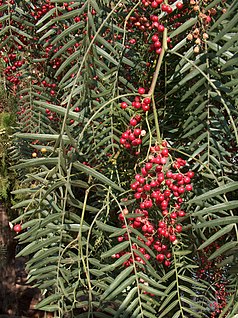Tunari National Park
| Tunari National Park | ||
|---|---|---|
| Tunari massif, Cordillera of Cochabamba | ||
|
|
||
| Location: | Cochabamba , Bolivia | |
| Surface: | 3000 km² | |
| Founding: | 1962 | |
| Peruvian pepper tree | ||
| Gray-necked Gilbammer | ||
The Tunari National Park (Spanish Parque Nacional Tunari, PNT) is a national park in the eastern Andean high mountain region in Bolivia, South America, with an area of 3000 km².
location
The national park is part of the Cochabamba Cordillera and is located in the Cochabamba department . The national park stretches in a semicircle to the north around the cities of Sacaba , Cochabamba and Quillacollo . The highest point within the national park is the Cerro Tunari at 17 ° 17 ′ S , 66 ° 22 ′ W with a height of 5035 m above sea level. NN .
The boundaries of the national park were set in 1962 "in the north of the mountain ridge in the Tablas region , in the south the bypass road that delimits the city according to the development plan, in the east the Arocagua gorge and in the west the Taquiña gorge ". A successor law in 1991 cut the boundaries of the park in the south to the height line 2750 m, in the east to the river Kenko Mayu (or Kenko) and in the west to the northern edge of the Parotani river .
Goal setting
The main aim of the park was to find solutions to the specific problems of the city of Cochabamba and its neighboring communities. These problems are mainly the lack of drinking water in the dry season and flooding in the rainy season. In addition, the torrents from the gorges to the north wash earth, tree trunks and stones into the valley, and mudslides destroy fields and houses.
Emergence
The Parque Tunari was created in 1946 north of the city of Cochabamba on the basis of a decree of August 2, 1939. However, this measure had little success, as on the one hand grass areas continued to be torched and trees felled by surrounding communities and by large landowners, on the other hand the apparently fallow areas were populated by the rapidly migrating population right up to the foot of the mountains.
However, the natural disaster of 1958 showed the urgency to contain mudslides and floods through protective measures and settlement bans. Therefore, by decree of March 30, 1962, the Parque Tunari was rededicated as a national park and raised to the status of law in 1983. In concrete terms, this meant that the management and maintenance of the park were raised from the local level to the national level, thus enabling the central government and the armed forces to intervene.
The persistent population pressure and the weakness of the national and regional administration could hardly prevent "spontaneous" settlements far into the national park, the sealing of the soil and the pollution of the surface water by latrines in the following decades. This did not change with the fact that in 1968 the park was subordinated to the Ministry of Agriculture and a funding committee was founded.
activities
Despite the barely slowed down immigration and settlement within the national park, effective measures have been taken in some areas of the park in the past decades to reduce soil erosion and landslides during seasonal rains and to stabilize the water supply. These measures mainly included reforestation measures, the establishment of a forest tree nursery, the construction of dams and security of the measures by security personnel. The park administration is supported by the Agencia Suiza para el Desarollo y la Cooperación (COSUDE) , the Swiss Government's Agency for Development and Cooperation ( SDC ) .
flora
The national park has two plant-geographical zones. The vegetation of the mountain slopes includes Peruvian pepper tree , Prosopis juliflora , Acacia macracantha , while Polylepis betteri and Buddleja coriacea dominate the mountainous region .
fauna
163 bird, 30 mammal, two reptile and two amphibian species have been registered in the park. These include the bird species red-flanked Andean hummingbird , black-bellied Andean hummingbird , giant pointed beak , gray- shouldered hooked beak , Iquico panties ( Asthenes heterura ) and gray-necked gilbammer ( Sicalis luteocephala ).



